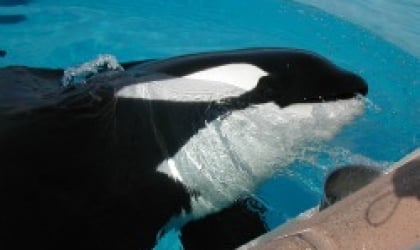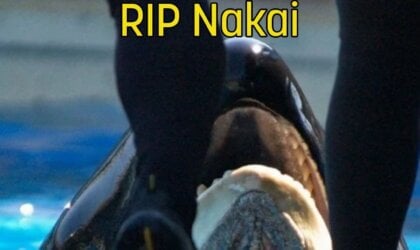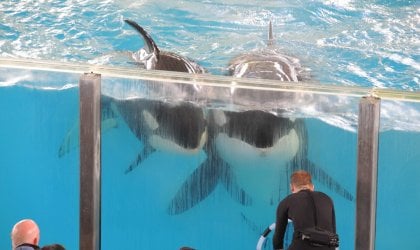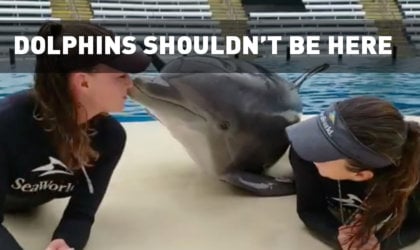Update (September 16, 2022): How many more orcas are going to die at Loro Parque in Tenerife, Spain, before this marine prison is shut down? On September 15, orca Kohana died at just 20 years old at Loro Parque, decades short of her natural life expectancy. She is the third orca to die at the facility in the last 18 months, following Ula, who was just 2 years old, and Skyla, who was 17.
Who Was Kohana?
Separated from her family and transported from SeaWorld Orlando in Florida at just 3 years old, Kohana spent years confined to a barren concrete tank and was forced to perform demeaning tricks in exchange for food to entertain humans. It’s tragic that she was never able to experience the feeling of freedom and that her only peace came through death. She deserved so much more.
Update (March 18, 2021): At only 17 years old, Skyla, the youngest orca at Loro Parque, has died. In 2006, when she was just a 2-year-old, SeaWorld Orlando in Florida kidnapped her from her mother and shipped her to Loro Parque in the Canary Islands. There, she spent her short life in constant confinement. According to Loro Parque, the results of the necropsy showed that the cause of death was intestinal torsion, which caused her to go septic and die. While the cause of intestinal torsion is elusive in a lot of cases, it has been linked to chronic gastrointestinal disease, dietary indiscretion, trauma, and frantic or erratic behavior in cetaceans and an array of other species. While it’s possible for intestinal torsion to develop suddenly and lead rapidly to death, it’s unlikely that her condition wasn’t precipitated by some other malady (like chronic or acute infection), trauma, or abnormal behavior.
Skyla is one of 21 orcas fathered by Tilikum, the subject of Blackfish. He was abducted from his ocean home in Iceland in 1983 when he was only 2 years old, and he died at SeaWorld Orlando in 2017 after being used to produce over half the orcas born at SeaWorld.
Skyla is the latest orca confined to a wholly inadequate tank to die young, but she certainly wasn’t the first and won’t be the last. SeaWorld has seen more than 40 imprisoned orcas die prematurely—and they’ll continue to die young as long as they’re forced to live in small, barren, concrete tanks.
Original post:
Loro Parque (Spanish for “parrot park”) is a zoo and marine theme park located on the island of Tenerife in Spain’s Canary Islands. Loro Parque displays captive birds, dolphins, and sea lions and, in partnership with SeaWorld, keeps orcas in cramped tanks.
 © DigitalGlobe | © GRAFCAN
© DigitalGlobe | © GRAFCAN
SeaWorld “loaned” the facility four orca calves to launch Loro Parque’s “Orca Ocean” in 2006. Keto and Tekoa came from SeaWorld San Antonio. Kohana and Skyla—who were taken from their mothers at the young ages of 3 and 2, respectively—were from SeaWorld Orlando. These massive ocean-going animals were flown thousands of miles in a wide-body transport plane, and cranes were used to move them from their plane transport pens into the tanks.
SeaWorld was heavily involved in “managing” the orcas, including overseeing their care and training. A SeaWorld senior trainer was reportedly supervising the training session in which Keto killed trainer Alexis Martinez in 2009. After that, SeaWorld tried to distance itself from Loro Parque. In 2018, SeaWorld finally relinquished ownership of the orcas—leaving Loro Parque to breed more orcas into a life of deprivation, contrary to SeaWorld’s corporate policy to end the practice.
We worked with SeaWorld on every aspect of this program.” —Patricia Delponti, Director of Communications and Public Relations at Loro Parque
Since the launch of Orca Ocean, two orcas have been added. Morgan was found stranded and taken from her ocean home to a Dutch dolphinarium on the promise that she would never be publicly displayed and would be released back into the ocean as soon as she was rehabilitated—but that never happened, and she was ultimately transferred to Loro Parque to suffer in confinement. Two calves both inbred, have been born at Loro Parque: Vicky, who died when she was only 10 months old, and Adán.
Two PETA staffers visited Loro Parque and filmed orcas who had fractured teeth and other injuries, listlessly floated in small tanks, and appeared to have mucus running from their eyes. Dr. Heather Rally, a wildlife veterinarian with experience with marine mammals, reviewed the footage.
Here is what Dr. Rally found:
1. Frustrated orcas bite the sides of the tanks.
Orcas are intelligent animals who work cooperatively, have sophisticated social structures, communicate using distinct dialects, and swim up to 100 miles every day. Being denied the opportunity to engage in such natural behavior leaves orcas frustrated. With little else to do, they neurotically mouth and bite the sides and gates of the tanks.
An orca who was confined to one of the smaller back tanks floated on the surface and was seen rubbing his or her head against the concrete.
2. Many orcas have missing or broken teeth.
The orcas’ worn and damaged teeth were visible when they opened their mouths to accept food. Some orcas have teeth that are completely missing or ground down to the gumline. Many of the orcas at Loro Parque had exposed pulp cavities.
Open pulp cavities were identified by Dr. Rally on the left side of this orca’s mouth. Orcas often fracture their teeth when biting on hard surfaces in their tanks. Fractured teeth are prone to infection, and orcas are often forced to endure drilling procedures that are likely painful because of the presence of nerves and living tissue inside the teeth.

Park workers drill into the teeth in order to open a cavity that allows for daily cleaning.
This daily cleaning is done to reduce the risk of serious infection that can cause illness or even death in captive orcas when their teeth inevitably become fractured or severely worn. However, some orcas still suffer from these complications in spite of the procedure.

Skyla was observed begging for food at the stage. She appears to have a missing tooth.
According to Dr. Rally, orcas in nature don’t typically lose their teeth, so Skyla’s tooth was likely pulled because of trauma or an infection. Several of her other teeth are worn down to expose the pulp cavity. Also, note the blue tint on some of the orcas’ teeth. It may be from the tank’s blue paint.
As a result of unnatural behavior such as biting and chewing on the concrete or other hard surfaces in their tanks, the first three or four teeth on both sides of Keto’s mouth are completely or partially worn down.
After performing a trick, Keto again opened his mouth and revealed exposed pulp chambers on four teeth that are completely worn down to the gum line.
A third orca appeared to Dr. Rally to already have significant wear on several teeth.
Tekoa, confined to the smaller medical tank, opened his mouth, exposing a number of pulp cavities.
3. Orcas float listlessly and exhibit atypical behavior.
Wild orcas are inquisitive, energetic, and almost always on the move. Orcas at Loro Parque often float motionless at the surface, repeatedly bob, or beg nearby trainers for food.
Keto was seen floating at a gate and eventually turned onto his side in what Dr. Rally says may have been an effort to keep an eye on the trainers walking over the bridge.
At the conclusion of one of the shows, this orca proceeded to float lethargically on his or her side and bob up and down.
Apparently prompted by lack of stimulation or a search for food, Adán, the youngest orca at Loro Parque, slid in and out of the water.
This odd behavior was seen repeatedly.
4. Trainers lock orcas in the smaller tanks and ignore them.
Orcas are sometimes kept isolated in holding tanks, and trainers pay little attention to them. From the very beginning of Orca Ocean, SeaWorld officials taught Loro Parque orca trainers, including during sessions at SeaWorld’s San Antonio and Orlando parks. SeaWorld’s corporate mindset and how its trainers view and treat the orcas have driven the trainers’ attitudes at Loro Parque.

Orcas have so little to keep their bodies and minds engaged that they beg nearby trainers for food by opening their mouths. The Loro Parque trainers, who learned from SeaWorld trainers how to interact with orcas, generally ignore them.

These two orcas, Kohana and Keto, were filmed while locked in a medical tank, which is also used as a holding tank. They attempted to get food or attention from trainers, but they were completely ignored.

Without sufficient space to swim around, they continued to float listlessly.
An orca believed to be Morgan was observed by Dr. Rally in the back tank splashing and trying to get the attention of a nearby trainer.
Tekoa was locked in the medical tank for the duration of the second show. According to Dr. Rally, he exhibited signs of agitation and a need for mental stimulation as he bobbed up and down, floated aimlessly, and lingered near the gate.
5. Orcas have “rake marks” caused by aggression and attacks from tankmates.
Rake marks appear when dominant animals scrape their teeth against the skin of less aggressive animals. Lower-ranking members of the forced and unnatural grouping are routinely bullied but have no way to escape. These attacks can result in painful and serious injuries, and some have reportedly been so severe that blood seeped from orcas’ wounds.
This orca, who was locked backstage, has a small rake mark on the side of the body.
Morgan, who slid out of the water during a performance, has two sets of rake marks on her left side.
Tekoa slid out and rotated on stage during a performance. Dr. Rally observed extensive rake marks on both sides of his body that ran from his head to his tail fluke. The orca’s dorsal fin also appears to be collapsing, which is the result of having inadequate space to swim and dive.
Later, Tekoa flipped onto his side, exposing rake marks along his body and fin.
6. Some of the orcas have mucus running from their eyes.
The observers and Dr. Rally saw a clear mucus-like substance hanging from Keto’s left eye, possibly because of irritation from the chemically treated water.
Learn more about cruelty at SeaWorld on The PETA Podcast:
Listen to more episodes on iTunes, Stitcher, and Spotify! Subscribe for new episodes.




